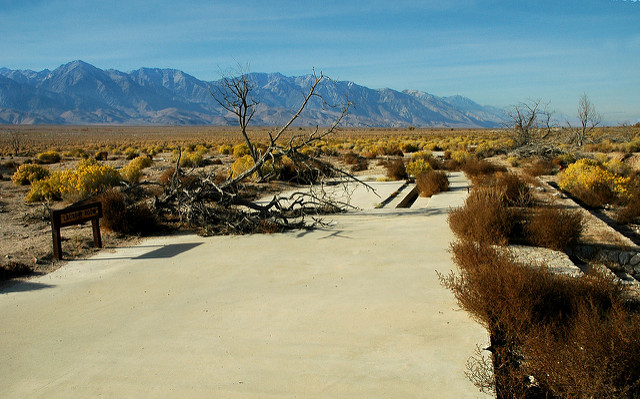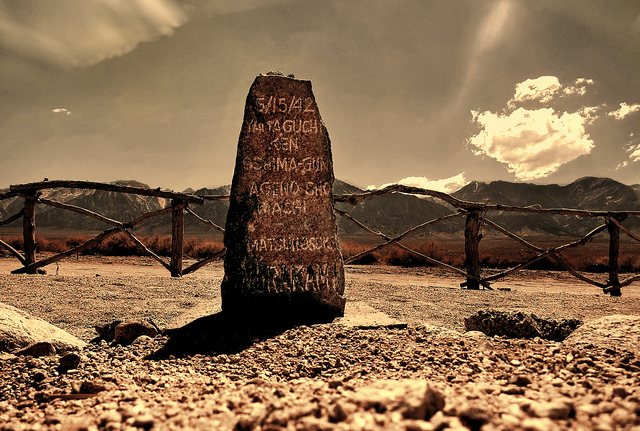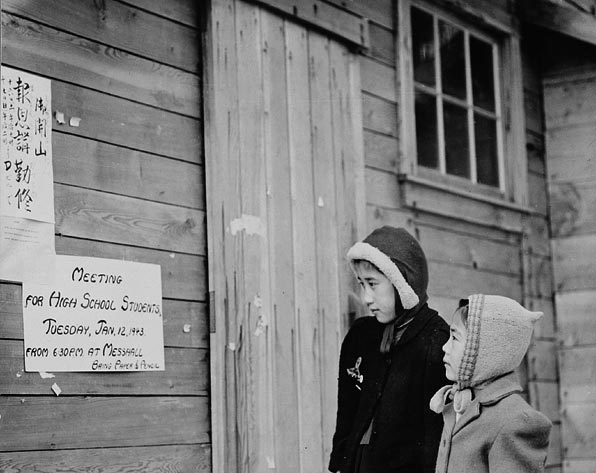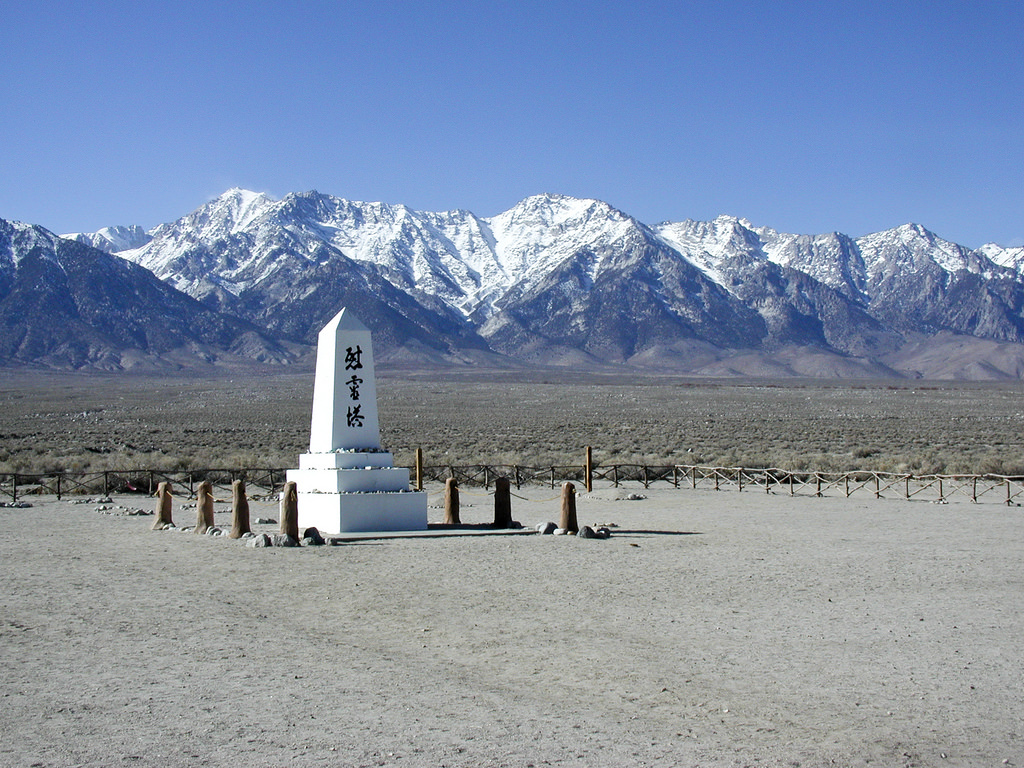The internment of Japanese Americans.
Try dropping that phrase into your next conversation with a group of your peers; I suspect the array of responses you get will be dazzling. Grim looks of vague understanding, evasive squirming, bitter anger behind some eyes, and of course, a few blank stares. Actually, you’re likely to get more than a few of those.
Those blank stares arise from the sad fact that teaching the history of Japanese American internment has been arbitrary in American schools for decades. And don’t blame it on Millennials. In adults born in the years between World War II and the early 1990s, there is a serious gap in knowledge and comprehension. Many educated people in their 20s, 30s, 40s, even 60s graduated from public and private schools with barely a passing understanding (if that) of the incarceration of over 120,000 Japanese Americans between the years of 1942 through 1946.
However, in light of Trump surrogate Carl Higbie’s November statements that the WWII internment of Japanese Americans serves as a “precedent” for the Trump proposed Muslim registry, an understanding of what Japanese Americans endured may be more vital than ever.
I recently had the opportunity to ask over 150 Americans (and a few Canadians) when they first learned about the WWII Japanese American internment camps. It was an informal survey, but people were willing to be forthright as long as they remained anonymous.
Between the ages of 23 to 75, responders’ education levels ranged from high school to Ph.Ds, with the majority of people having been educated in public middle schools and high schools. All major regions in the US were represented (the only exception was Alaska). In addition, the Canadians in the group were educated in British Columbia and Toronto, though they currently live outside of Canada.
I purposely did not ask how each person voted in the presidential election. Some responded to me privately (via email), others shared their responses with the group.
I asked everyone:
Do you know what the WWII Japanese American internment camps were?
If you do, where/when did you learn about them?
How would you describe your understanding? Vague, in-depth, nonexistent, etc.?
Surprisingly, age did not seem to have too much of a bearing on a person’s knowledge of the camps. Individuals in their 30s talked about the lack of coverage in their history classes just as much as people in their 60s and 70s.
The one outlier, oddly enough, was a 10-year-old boy. A woman volunteered the fact that her son in 4th grade had spent the year thus far learning all about Japanese internment, as well as other concentration camps in the course of history. At this fellow’s tender age, he may well be more educated than a large number of adults in America. Perhaps there is hope?

Overwhelmingly however, most adults explained that their first exposure to the fact that internment camps existed on American soil in the 20th century was through elective reading or honors/AP classes, outside reading, or through film or television – not the regular curriculum in schools. Repeatedly people shared experiences like:
“Sophomore year of high school we read Obasan in AP English and it was the first and only time I learned about them. We never covered it in history class.”
“I’m 44 – grew up in Ohio. I don’t remember any mention of it. I’m sure I heard something about it as a young adult, but it was minimal. I think George Takei really gave me the best intro.”
“I read it in a book of my Dad’s when I was 17 or 18 and was stunned. I asked him about it because I couldn’t believe it was true. He assured me it was and probably the reason I’d never heard about it was because our country was ashamed of it. I’m just shy of 65 years old.”
“I learned about them in 2nd grade but they had to bring in supplemental readings because it wasn’t in the history book. We vaguely when over it in high school. Didn’t learn about it in detail until a women’s study course in college where we read poetry written by someone who was there.”
“I am 39 and I think I learned about them initially in, like, 4th or 5th grade social studies in Cherokee County, GA in the mid ‘80s. Nothing in detail — probably just a sidebar in our books. But that was supplemented by outside reading — I was pretty committed to reading the entire library when I was a kid.”
“I learned about them first in grade school (maybe 9 or 10) but they brushed over them. At the time, it didn’t seem too bad. Freshman year of college I read When the Emperor Was Divine, which told a young girl’s experience in the internment camps, which provided a much more vivid picture of what really happened. I found it both sobering and distressing. I am now 24.”
“I learned the little I know from George Takei and NPR. And I’m embarrassed to say I only learned about it as an adult. Like in the last 10 years.”
“I was 11 or 12, so 1972 to ’73ish. I read an interview with Pat Morita and wanted to learn more.”
“I don’t remember hearing about them in school. The first time I remember hearing about them was — of all places — on the TV show Strangers with Candy in 1999 or 2000.”
“We learned virtually nothing about it in school except for a few passing mentions, and I think it’s very telling that when I was in middle school, we had a Holocaust survivor who came in and talked to the class, but we didn’t have an internment camp survivor, despite the fact that there were several in the community. I also don’t remember reading any internment camp books until I got to high school, at which point we read Snow Falling On Cedars and A People’s History of the United States and talked about the camps in a bit more detail. I went to school in a pretty liberal part of Northern California where a lot of people definitely identify as progressive — we had lots of hippie-ass stuff in school around things like conflict resolution and grades.”

About 10 percent of the 150 people said they didn’t learn about the camps until college.
“I never heard of them until I was in college at Arizona State University in the late ‘80s. I was shocked. I grew up on the east coast and had never heard about it. One of my professors worked with the incredible poet Mitsuye Yamada whose family was interned.”
“I didn’t learn about them until college, anthropology class at USC. I remember feeling so angry that my high school offered no history about this. I then gave an informative speech about them in my speech class the following semester at USC. Only 5 out of a class of 60 had heard about it before.”
“I don’t think I knew about them until undergrad. I was homeschooled up until then and had never even heard about it. I did a little research on the subject, but the majority of what I know about them came from watching Allegiance: a New Musical [based on George Takei’s internment experiences] on Broadway this year, to be honest.”
It should be noted that almost half of people mentioned George Takei as instrumental in learning the truth about the camps. Though I did not first learn about the Japanese internment from Takei, my first exposure was also through the theater. There’s no doubt that the arts (theater, film, television, literature, etc.) are a powerful tool in which to educate people on the darkest parts of our history.
Of course, some tried to rationalize that the reason it wasn’t properly taught in American schools was because it is such a shameful part of our history; that “America” wants to “understandably” sweep it under the rug. While it was pretty unanimous that the internment was an atrocity enacted upon Americans whose only crime was being of Japanese descent, some voiced a sympathetic understanding of why it usually isn’t taught properly in schools. “Our [non-Japanese] parents and grandparents lived with the Japanese camps, observed it firsthand,” one person reasoned. “Maybe people are embarrassed? Do we judge them? [past generations] They were told to be afraid, as Americans.”
As Americans.
It’s this brand of fear-tainted patriotism that may prove to be dangerous to Americans in the near future.
“I learned about them in 8th grade US history in southern CA, which was 15 years ago (I’m 28 now). Although the time spent on the subject was very brief (maybe one full day), we did get a clear picture of what it was and that it is an embarrassing part of our history as a nation. However, I will say that it was taught to use with a very nationalist spin, as our teachers wanted us to know that ‘Yes, it was really bad, but hey! It wasn’t that bad…’”

American schools as a whole may not have overtly downplayed the Japanese American internment, but the mere fact that it is glossed over, reduced to a sidebar on a page of a history book (nearly a third of the responders used the word “sidebar” to describe how they learned about the camps) tacitly teaches Americans that it “wasn’t that bad”.
What is even more troubling is that Americans young and old are being bombarded with false, hackneyed information about Muslims, Muslim Americans, Islam, and ISIS, creating the belief that to be an American means to distrust and fear a specific race and ethnicity in America. As with the above quote regarding the “embarrassment” of former generations, there is a ploy to be sympathetic to those Americans who are fearful of the potential threat — then Japanese Americans, now Muslim Americans. They just want to be safe in their country!
Their country.
“The president needs to protect America first,” Higbie maintained when talking about the proposed Muslim Registry in the same breath as the WWII internment camps. It is that separation, “them” vs. America, danger vs. safety, that puts so many Americans in the crosshairs.
I fear that the incoming administration will play on American ignorance of the past to garner support for a Muslim registry. Have we already condemned ourselves to repeat our not-so-distant history?
But there was some hope in the responses I got from people. While those that typically received the most thorough education about the camps came from the west coast or, more precisely, the state of California, several individuals from states that are considered “less progressive” or conservative received a solid, even exemplary education regarding Japanese American internment.
One such person remarked, “In Wyoming we learned about them in 5th to 7th grade in a full class, because one was in Wyoming at Heart Mountain. It was reparation, I feel. The teachers taught it like they were ashamed, as if they did it themselves.”
I followed up by asking this person, “What kind of school did you attend?” The individual replied:
“You have to understand that there were no private schools. There were a handful of grade schools, one junior high, and one high school in town. All public. We grew up feeling guilty for the internment camp, the Indian reservations (which we visited many times), and the Civil Rights Movement. Now I’m sure junior high kids feel personally responsible for Matthew Shepard. It’s a different kind of wall [from Trump’s wall] in my town, but a wall, nonetheless. It separates us, stops us from moving on; like ‘I feel I’ve wronged you before even knowing you.’ It’s weird. I don’t know how to take that wall down.”
I wonder how Americans regard “personal responsibility” in the face of building an America where people must register themselves, their children, in order to keep their white neighbor “safe”? Do people fathom that personal responsibility, their hand in condemning certain Americans to existing as a liability or threat? A registration number?
The responder from Wyoming left me with this, which I leave with you now:
“I guess what I mean is: At what point is someone like me allowed to say, ‘This is awful and we must share so it doesn’t happen again, but it’s not personally my fault?’ Or is forever feeling personally guilty the only reparation I can offer?”
It is my sincere hope that future generations do not need to ask themselves these questions in the aftermath of a Trump presidency.
Photo: A monument marks the location of Manzanar, an internment camp razed after the Second World War, Jason Hickey/Creative Commons

